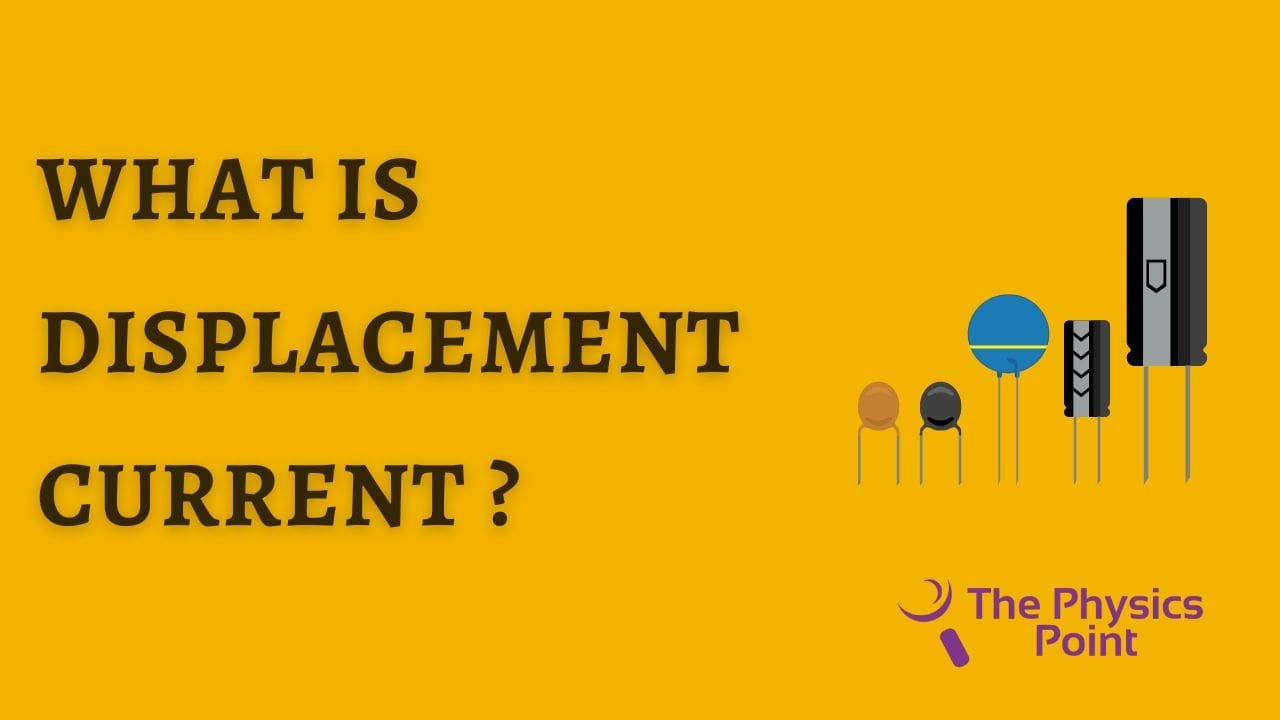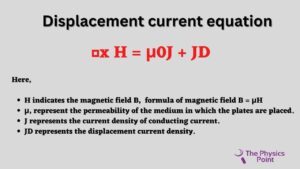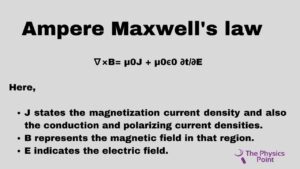What is Displacement Current? Definition, Formula, Density

Hello everyone how are you welcome to the website of physics – the Physics point. After the topic of the electromagnetic wave spectrum, we are again presenting a new and interesting article on what is displacement current. Displacement current is a phenomenon that represents many important things inside it. We can observe this type of current in the capacitor between the plates. This current show the same behavior as a normal current shown. to understand the displacement current read the whole article What is Displacement Current carefully from start to end.
In today’s topic, we are going to discuss some important questions Such as what is displacement current, the formula for displacement current, displacement current formula, displacement current density, displacement current equation, and electric displacement current. These questions are very important and I request you to read the article with your free mind. So that no concept will be missing from your understanding. Let us start our article (What is Displacement Current) without wasting time.
What is Displacement Current (Definition)?
This is a type of current that is explained by Maxwell equations. displacement current definition is given in terms of the rate of change of the displacement of the electric field. this type of current can be observed in capacitors. The SI unit of the displacement current ampere is the same as the normal current. The main factor of the displacement current is due to the changing of electromotive force. you must know that the magnitude of this displacement current in case of the steady electric field inside a conducting wire is always zero.
The formula of this displacement current is given below-
Id = E0 dΦE/dt
- Id represents displacement current
- E0 Represents the permittivity of Free Space
- dΦE indicates the changing electric field
- dt represents the change in time
The generation of a dipole moment observed when there is any charge separation between atoms and ions results in the formation of two terminals. the first one is positive and another one is negative inside a molecule or any other substance. and the generation of an electric field happened after this. the displacement current especially refers to the electric current which is following between the two conductor plates in the medium or vacuum. the conduction current occurs to form when there is a constant electric field over a time period. This displacement current is very essential to understand the characteristic of different types of electromagnetic waves.
Displacement Current Equation
This current has the same dimension and unit and also the same effect as the normal current. displacement current show the same effect of magnetic and electric field the equation of the displacement current is explained by Maxwell’s equation which is given below.
⛛x H = μ0J + JD
Here,
- H indicates the magnetic field B, formula of magnetic field B = μH
- μ, represent the permeability of the medium in which the plates are placed.
- J represents the current density of conducting current.
- JD represents the displacement current density.

What is Ampere Maxwell’s Law?
According to this law, the line integral of the magnetic field around a packed loop or closed loop is equal to the μ0 times the total conduction current and the displacement current also. The equation of Maxwell’s ampere law is given below-
∇×B= μ0J + μ0ϵ0 ∂t/∂E
Here,
- J states the magnetization current density and also the conduction and polarizing current densities.
- B represents the magnetic field in that region.
- E indicates the electric field.

Association of displacement current with the electric and magnetic field?
In Physics as we know according to Faraday’s law in the chapter on electromagnetic induction, the variable magnetic field exists then it induces an EMF. In this way, if the electric field is also time-varying, it generates a type of current and also a magnetic field, and this type of current is called displacement current. it means the electric and magnetic fields behave in a symmetrical way with respect to the displacement current.
Faraday’s law of magnetism
Faraday was a great English scientist. He contributes many concepts in physics and works on electromagnetic and Magnetism theories. Faraday’s first law of electromagnetic induction, states that whenever a conductor is placed in a changing magnetic field an electromotive force is induced in that conductor. If that circuit is closed in which the conductor is set up, the current is flown. This current is called induced current. This induced current always opposes the cause due to which this current originated.
Frequently Asked Questions (FAQs)
Ques. What is the reason of arising the displacement current?
Ans. The displacement current arises by the reason of changing electromotive force.
Ques. In which unit do we measure the displacement current?
Ans. The displacement current is measured in the SI unit and the unit of this displacement current is the ampere.
Ques. When we connect a capacitor with the displacement current what is the magnitude of the output?
Ans. We get zero output from the capacitor.
Ques. How can you distinguish the conduction current and the displacement current?
Ans. You should know everyone that the conduction current Rises due to the flow of electrons in the conductor but the displacement current arises from the time-changing electric field. And the very important thing about this current is that it cannot exist in steady conduction.
Ques. Which type of current exists in a capacitor?
Ans. A special type of current in a capacitor exists that is called displacement current.
Conclusion
So guys in this article (What is Displacement Current) you have read about many different things about displacement current. Many important questions such as the definition of displacement current, displacement current definition, and why is displacement current necessary are discussed in this article very well. After a long discussion about what is displacement current if you have any doubts or suggestions you can ping us in the comment section box. We will meet you again the next day. Thanks!
